“But he does it at home!” Usually uttered in a plaintive wail, this common dog owner complaint is often heard in dog training classes, among other places. When one of my students says this, I reassure them that I believe their dog probably does perform the behavior in question with a high degree of reliability in the comfort of his own home. The fact that he won’t do it in class is usually a generalization issue; the owner has only practiced the behavior with her dog at home. He doesn’t know he’s supposed to do it other places.
According to authors Mary Burch, PhD, and Jon Bailey, PhD, in their excellent book, How Dogs Learn, “Generalization occurs when behaviors are seen in contexts other than those in which they were originally trained.” Simply stated, this means practicing with your dog in different places, at different times of the day, under different conditions, in the presence of different people, dogs, and a variety of other distractions.
People who compete with their dogs in obedience, rally, and other canine sports – at least those who compete successfully – understand how important this is. They call it “proofing” when they help their dog generalize his show ring behaviors to new and distracting environments. They make sure to “proof” their dog for typical show ring distractions such as wild applause, metal chairs clattering to the floor, flash bulbs going off, and a dog owner shouting conflicting cues in a commanding tone in the next ring.
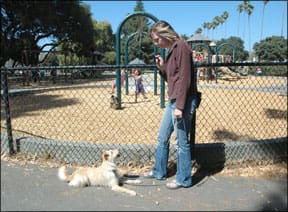
You may not need to take it to that extreme, but if you want your dog to perform his behaviors as well in public as he does in the privacy of your own home, you will need to help him learn how to generalize.
Monitor your expectations
If you teach your dog new behaviors such as “sit” only at home in the den on the rug in front of the coffee table, your dog will believe that “Sit!” means “sit in the den on the rug in front of the coffee table.” That’s it. If you never ask him to sit anywhere else, that will be the sum total of his “Sit” association.
It’s not fair, then, for you to get irritated, frustrated, angry, or annoyed and claim he’s “blowing you off” if he fails to sit when you ask him to do it in the waiting room of your vet’s clinic surrounded by a barking Pomeranian, two cats yowling in their carriers, and a parrot squawking loudly on his owner’s shoulder. Even well-trained dogs might have difficulty responding to the cue in that environment! If that seems too obvious, it’s just as unfair to expect him to sit the first time you ask him to sit in your kitchen, or on the sidewalk in front of your own house, regardless of how well he responds to that cue in the den on the rug in front of the coffee table.
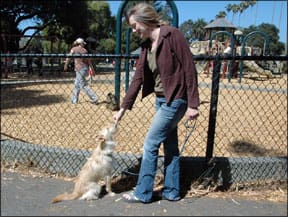
Trainers frequently say, “Dogs don’t generalize well.” What we mean is that dogs don’t generalize “operantly” trained behaviors (you do this, you get a cookie) without some assistance from their humans. The good news is that your dog can become quite proficient at generalization, if you take the time to show him how.
How to generalize
Generalization really is quite simple. To start, make lists of all the variable conditions in which you might ask your dog to respond to your cue for a particular behavior (see “Generalization Variables,” right). Train that behavior to a high degree of reliability – 80 percent or better – in the den on the rug in front of the coffee table. Take “Sit,” for example. When your dog will promptly and consistently sit at least 8 out of 10 times when you ask him to, you’re ready to start generalizing.
Add a variable. Ask a friend to stroll through the den, and cue your dog to sit. (Still on that rug in front of the coffee table!) If he does it, click and treat (if you are not familiar with this phrase, see the Review sidebar, below). If not, prompt the sit with a food lure or a hand motion, to remind him what “Sit!” means. When he does it, click and treat. Repeat this exercise with your strolling partner until your dog responds reliably even with the distraction of a moving person.
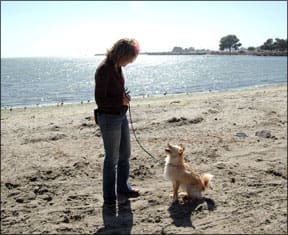
Now add a different variable. Have another volunteer bounce a ball on the den floor, opposite side of the room. Cue the sit, prompt if necessary, click and treat when he does. When he’s reliable with the bouncing ball, try changing the venue – move him several feet off the rug and work up to reliability, then add strolling spouse and bouncing ball.
Okay, there’s a whole world out there and you and your dog haven’t even left the den yet. Your next step is to practice his sits in various rooms of the house, first without, and then with, additional distractions. During this phase, you can also generalize him to your own body positions: sometimes ask for the sit while he’s facing you, sometimes next to you and behind you, and sometimes when you’re sitting, or even lying down.
Taking it on the road
But you’ve only just begun; you’re still in your house! When your dog will sit consistently and reliably anywhere inside, it’s time to go outside. Ready for your walk around the block? Have your dog sit at the door – a “Say please” good manners behavior that is appropriate to practice anywhere, anytime. When the two of you step outside, ask for a sit on the front stoop. Prompt if necessary, click and treat when he responds. Ask for sits several times as you make your way around the block, making sure to prompt him if he needs help, and rewarding him each time he sits.
As your dog becomes more and more responsive to your sit cue in an environment with infinite possibilities for distraction (other dogs, squirrels, cars, bicycles, cats, mail carriers, baby strollers, joggers, etc.), you can gradually start decreasing the rate of reinforcement. Sometimes ask for a sit, praise him when he does it, then ask for another, and click and treat when he responds. By decreasing the rate of reinforcement you make the sit response very durable (resistant to extinction). He’ll learn that if he keeps playing the “sit game,” like a slot machine, it will eventually pay off.
The rest of the world
Your home and your walk around the block are still relatively limited environments. Now you get to generalize your dog’s sit behavior to the rest of the world. Take him with you to the bank and practice sits while you wait in line to make a deposit. Visit your vet’s office and just hang out in the lobby practicing sits. Go to your favorite pet supply store and practice sits in the aisles. Walk past a school playground and reinforce sits in the presence of children running and playing. And oh yes – then you get to do the whole procedure with all the other behaviors your dog is learning. Phew!
The good news is that generalization seems to, well, generalize. The more you do the process, the easier and easier it becomes for your dog to generalize new behaviors. So, while it may take a concerted effort to help him understand that sit means sit everywhere, when he gets that figured out, he’ll generalize each new behavior more quickly.
The other piece of good news is that you don’t have to restrict yourself to one behavior at a time. If you’ve already taught him sit, down, stand, and target on that rug in the den in front of the coffee table, you can go ahead and practice all four behaviors when you take your generalization show on the road. So – get going on your generalization program! You and your dog have a lot of work to do if you want him to be a truly well-trained, well-behaved canine companion, wherever your travels together may take you.



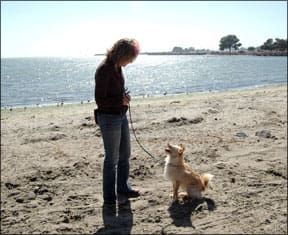

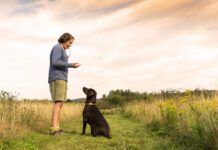

I tach my dog all the basic with out paying nothing my dogs are really intelligent